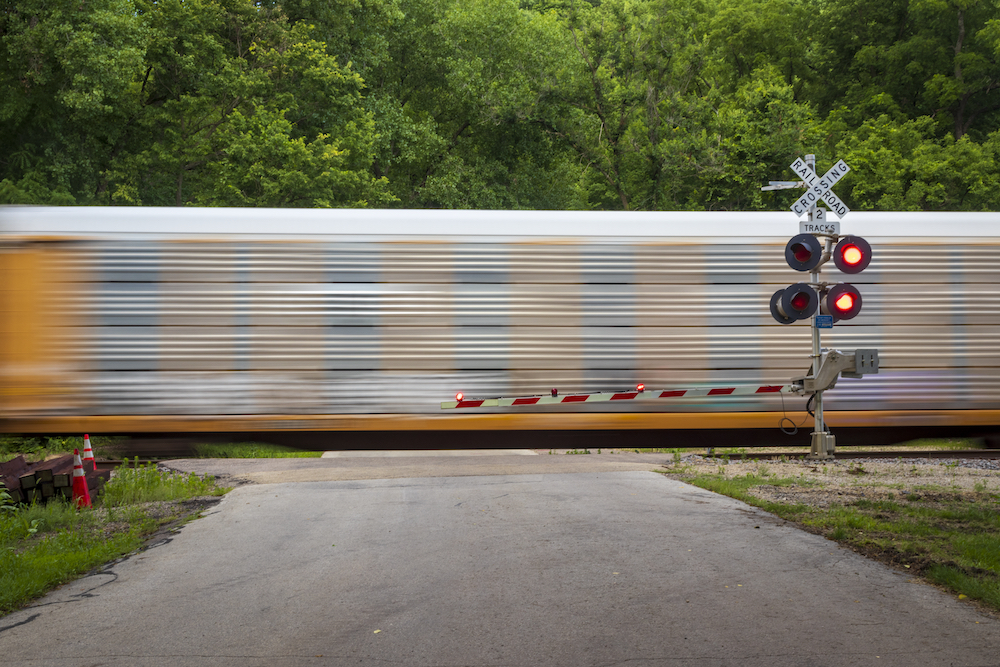
Why is it that no one notices railroads until there’s a derailment, blocked grade crossing, or a massive supply chain problem like we saw in 2022?
If it weren’t for bad press railroads wouldn’t get any at all. It’s as if the railroad industry – all 140,000 miles of it – is invisible until things go haywire.
A case in point: Last week the U.S. Department of Transportation created an advisory committee to shape the federal government’s approach to transportation innovation, with a focus on automation, cybersecurity, and sustainability, among other things. Its membership includes precisely no one from the rail industry.
That’s right. No freight rail officials. No Amtrak, Brightline, or commuter rail people. No one from rail equipment manufacturers. Or the testing folks at MxV Rail in Pueblo, Colo.
This does not mean that there’s no tech innovation in the rail industry. Far from it. Startups Parallel Systems, Intramotev, and Glid are working on battery electric, autonomous freight cars. Automated track and train inspection systems are cutting edge. Freight car location and health monitoring systems are finally getting traction. And Wabtec is tying together its dispatching, yard management, and locomotive cruise-control systems with the goal of helping rail networks operate more smoothly, predictably, and reliably.
Yet the railroad industry, which handles roughly 40% of the nation’s long-distance freight ton-miles, was left off the federal panel. Rail wasn’t the only mode on the outside looking in. Neither aviation nor the maritime industry have a seat at the table, either. A DOT spokesman didn’t respond to an email asking why rail was left out.
“We are living in a time filled with unprecedented opportunity and unprecedented challenges in transportation,” Transportation Secretary Pete Buttigieg said in a statement announcing the panel. “The deep expertise and diverse perspectives of this impressive group will provide advice to ensure the future of transportation is safe, efficient, sustainable, equitable, and transformative.”
This, of course, begs the question: How diverse can the perspectives be if rail is missing? DOT put out a call for advisory committee nominations in July 2022. But the agency could have invited railroad representatives if no one from the industry had raised their hand.

If you pay attention to transportation policy — or, more precisely, the lack of it — these oversights aren’t surprising. The U.S. and transportation departments of all 50 states are focused almost exclusively on roads. It’s all about rubber tires rolling on pavement. And anything that doesn’t come equipped with a steering wheel is an afterthought.
You can understand why the Class I freight railroads would want to keep the feds at arm’s length. The phrase, “Hi, I’m from the government and I’m here to help,” comes to mind. But better coordination among transportation officials and all links in the supply chain — yes, that even includes railroads — can only be a good thing.
Since the committee aims to look at technology and safety across all modes of transportation, it seems like a golden opportunity to discuss ways to reduce the staggering number of grade crossing accidents. No longer are drivers just trying to beat a train to a crossing and losing. With their eyeballs on their phones, distracted drivers are now plowing right into the side of trains. There’s got to be a tech solution, right?
Railroads were once woven into the fabric of daily life in America. The DOT panel is yet another example of how railroads have faded from the public consciousness — even when the topic is transportation.
You can reach Bill Stephens at bybillstephens@gmail.com and follow him on LinkedIn and X @bybillstephens














When I was in grade school and Jr high in the late 40’s and early 50’s I remember being shown at school assemblies public relations movies produced by the AAR on U.S. railways, documenting their importance to our country. They were quite good and I do have a few video copies of these films in my video collection. In general I do not see the current industry ever engaging in efforts to actively promote public awareness of of their importance other than their “damage control” efforts after an accident or other negative news event.
As far as grade crossings accidents go, I have always been irked by headlines that read something like, “One Killed Three Injured After Train Hits Car”. Now, for the typical, non-railroad knowledgeable person reading a headline like that, it sends the message that the train was somehow to blame.
It happened again today (01/04/24). “Driver Critically Injured When Car Was Hit By Surfliner”.
Now, for most people reading that who know little about railroads, they’re given the feeling like, “Damn that Surfliner~!” Why didn’t he watch where the hell he was going?”
In more typical traffic accidents, headlines usually read more like, “Man Killed in Two Vehicle Crash After Driver Disregarded Stop Sign”.
It would be nice if news reports of grade crossing tragedies could also be presented like that. Like, “Person Critically Injured In Crash With Surfliner After Driver Disregarded Stop Signal”.
That would read much better and give the general public a clearer picture as to what actually happened. After all, most people read the headlines and that’s about all.
Bill has it right yet unless you have tracks in your proximity you pretty much don’t have interactions with trains or even see them on a weekly, daily, monthly basis so why would some care at all. They do see roads, from the moment they pull out of their drive until they get to there destination, they may not drive them every day yet they can see them out there front door most times. Airplanes pretty much fly over all the time, people see airplanes flying over to destinations near and far and even use them at times, driving on the same roads to get to the airport or heliport. Roads and airports are what pretty much what every politician glad hands with their constituents. Citizens want to be able to get to places quick and easy and politicians can say “see what I brought you!” even though they Voted against the bill to bring those monies into their district. It seems the only times any politician, from both parties, gets involved with rail is when a station is on the list to close, derailments, new infrastructure (even though they voted against it), complaints about lines that have been moving since before the town even had one resident etc…
Well the head man at the DOT has no railroad experience so . . .
I see that equitable is mentioned of course.
But, but, but, “Amtrak Joe” is POTUS! And all the folks at the NARP/RPA and its state/local affiliates were ecstatic at his election. Wonder what those folks think of this. As for “Mayor” Pete, there was a story at Trainorders.com’s Passenger Trains forum some months back claiming that he was making a trip DC-New York City. And he was booked on a flight. Then his flight was cancelled and even then he didn’t consider riding Amtrak. After bashing the airline, Petey drove (or was driven). I never saw any documentation of this but if true, that Petey wouldn’t even ride Amtrak on Amtrak’s only bedrock after 50+ years, it makes a mockery of “Amtrak” Joe’s supposed commitment to passenger rail.
134,000 Rail transportation employees move an impressive 40% of the freight in the U.S. I understand the basic concern about not being part of the innovation group. On the other hand, if I’m employed in the rail industry at any level, I’m looking for independence from most government engagement and meetings filled with discussions that don’t think about an integrated transportation network. In fact, I might point out to anyone inquiring about rail transportation integration to look at the daily consists of our trains. Seems to me the railroad has a lot of innovation and integration with other transportation modes
134,000 Rail transportation employees move 40% of the freight in the U.S. I understand the basic concern about not being part of the innovation group. On the other hand, if I’m employed in the rail industry at any level, I’m looking for independence from most government engagement and meetings filled with discussions that don’t think about an integrated transportation network. In fact, I might point out to anyone inquiring about rail transportation integration to look at the daily consists of our trains. Seems to me the railroad has a lot of innovation and integration with other transportation modes
In 1920 2,200,000 people worked on the railroad. The U.S. population was 106,000,000. 2% of the entire population were railroaders.
In 2023. 135,000 people work on the railroad. The U.S. population is 335,000,000. 0.4% of the entire population are railroaders.
There are no meaningful number of railroaders to explain to non-railroaders anything about railroading. No ‘civilians’ know anything about railroading, save what they see on any TV news show.
Boy I don’t give this Stephen’s enough credit i guess. A lot negative write ups but this one is so on target! Thank’s
Just like his last one on over regulation by the STB and USDOT keeping railroads from expanding into new territories or old unused lines with EIS’s where none is required because of their fear of being sued by the green crowd who usually only sues to delay something they are against, The vocal minority determining what is best for America and its majority population.
” The U.S. and transportation departments of all 50 states are focused almost exclusively on roads.”
Of course the states are focused almost exclusively on roads. They build, own and maintain them. They mostly fund them. Rails are private; waterways are US Army Engineers or US Coast Guard; aviation is FAA.
If you’re going with States, they’re going to be interested in where they spend their own money.
Well, if you ask me, which no one did, people with no business experience cannot identify root causes and act on them. The bunch in charge now are happy to bring in “experts” (academics) to conduct seminars and workshops that result in studies which end up on dusty shelves somewhere.
The third-to-last paragraph says it all. My late cat Burlington was no genius as cats go, but he was far brighter than Mayor Pete.